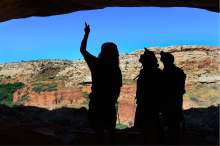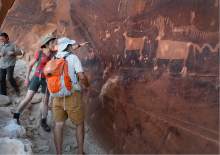This is an archived article that was published on sltrib.com in 2016, and information in the article may be outdated. It is provided only for personal research purposes and may not be reprinted.
The largest post-recession auction of Utah school trust lands brought $5.52 million for the trust's coffers and unease for some of the priced-out groups that prize the lands.
Parcels held dear by conservationists, hunters and a pioneer heritage group were among those sold Wednesday in Salt Lake City by Utah's School and Institutional Trust Lands Administration (SITLA).
Two parcels that generated particular interest — 390 acres on Comb Ridge in the proposed Bears Ears National Monument and 200 acres abutting Zion National Park on the Kolob Mountain road — were bought by Lyman Family Farm for $2.24 million, leaving outsiders to guess at the company's intentions.
The Hole in the Rock Foundation had nominated the Comb Ridge parcel for the auction and spotted $42,000 for SITLA to do its due diligence, with a view toward buying the land for its treks inspired by the eponymous 1879 Mormon expedition.
The foundation met the minimum bid of $284,000 — as did The Conservation Fund. But when one bidder countered Lyman's opening bid of $450,000, Lyman president Joseph Hunt pre-empted any further back-and-forth with a matter-of-fact "Five hundred."
Salt Lake City climber Niels Tietze had a more prolonged toe-to-toe with Lyman for 180 acres at Photograph Gap, near Canyonlands National Park and world-renowned crack climbing at Indian Creek. Starting from $160,000, Tietze met Hunt's casual re-raises by almost pleading his bids to auctioneer Kim Christy — eliciting laughter when he reduced his increments from $5,000 to $1,000.
His head in his hands, Tietze announced to the 60 or so in attendance, "I just can't believe how many years of your life you can put into like three minutes of this process."
Tietze would say afterward that he bid with money left to him by two deceased brothers, one of whom died climbing in Grand Teton National Park. He'd hoped to live off the land he'd planned to buy Wednesday.
It sold, instead, to Lyman for $270,000.
That was a pittance compared to Lyman's price for Cave Valley, billed by Christy as "the best" of the day's offerings for its hiking, sightseeing, camping and fishing near Zion National Park. Lyman wore down Montana-based recreation group Under Canvas Adventurers, settling at $1.74 million.
The National Parks Conservation Association had hoped to line up a conservationist buyer but couldn't on short notice, said representative Cory MacNulty. She said she doesn't know Lyman's intention but that her group plans to stress the importance of Lyman's stewardship to the park's future.
Last year, Lyman bought three 80-acre lots outside Tropic that offer scenic views of Bryce Canyon National Park. But Hunt was low-key about the purchases and said the company's interest is agriculture — even if a defeated bidder for 40 acres in Hanksville joked, "You can't put cows on that."
"I feel like I got beat up," Hunt said afterward. "We had a lot of strong bidders."
Friends of Cedar Mesa Executive Director Josh Ewing said his group and others in the nearby Bluff community are "saddened" that a portion of Comb Ridge is now in private hands, blaming the Hole in the Rock Foundation for opening a "Pandora's box" with its nomination.
SITLA had reduced the parcel from 640 acres to 391 acres after receiving input from conservationists, and the sale includes a deed covenant that protects about a dozen archaeological sites that were deemed "significant."
Ewing said the parcel is home to an ancestral Pueblo shrine and "very important" and rare Navajo sites that he hopes the buyer will safeguard.
"Anything that happens to those would be a loss of American history," he said.
Hole in the Rock government relations director Lynn Stevens said he believes the foundation will still derive its intended use from the land, even if it doesn't own it.
"Knowing the [Lyman] people who bought it as well as I do, I'd say [Wednesday's result] was good," Stevens said.
Sportsman groups took an interest in the auction, too, with more than 1,800 people having signed an online petition to protest the sale of what are regarded as prime hunting grounds. All told, more than 2,500 acres of value to hunters became privatized Wednesday.
Nearby property owner Ron Ufford bought 1,240 acres on highlands that overlook the Ashley Valley northeast of Vernal for just $150,000 more than the minimum bid — the lone bidder on a parcel billed as offering "incredible views" of Dinosaur National Monument.
Backcountry Hunters and Anglers board member Josh Lenart said the sale is a cautionary tale for fish and game enthusiasts who might support a state effort to sue for control of federal land.
"From a sportsman's perspective ... it'd be a catastrophe," he said.
SITLA oversees 3 million acres of state land, charged with generating revenue for an endowment that funds Utah's public schools. About a third of Utah's private lands once belonged to the trust.
Prospective buyers at its twice-annual auctions submit sealed bids. The three highest bidders and those bidding 80 percent of the third-highest bid are invited to take part in oral bidding.
Not included in Wednesday's $5.5 million total was the $700,000 sale of a 272-acre parcel northeast of Helper sold by Utah State University to Dave Barton and Marc Bingham. Valued at $840,000, the land includes warehouses, offices and manufacturing facilities built in the 1970s and once used for the College of Eastern Utah's mine education programs.
Twitter: @matthew_piper







